Introduction
Mortal Kombat is one of the most notable fighting game series, consisting of eleven main games and several spin-offs. The first Mortal Kombat was released in 1992 by an American company, and it changed the fighting game scene that was dominated by Japanese titles. The current essay thoroughly examines the history and gameplay of Mortal Kombat (1992), explaining its relevance to the popularity of fighting games in general.
Mortal Kombat History and Background
The fighting games originated in Japanese arcades with the creation of such titles as Karate Champ and Street Fighter. In the 1980s, these series drastically changed the way that people understood gaming, increasing the overall popularity of the genre globally (Stuart). In this sense, the release of the first Mortal Kombat in 1992 was crucial for the industry because it was developed by an American company (Midway Games) in the market dominated by Japanese games (Diver). Similar to other titles in the scene, Mortal Kombat was released on arcade platforms, and people could play it in various video game centers, bars, and amusement parks (Diver). Most of the game mechanics were familiar for fighting game veterans – 3rd person POV, control over one character, and fighting until one of the players loses all health points. The gameplay is roughly the same for modern fighting games, including Mortal Kombat 11 – the latest iteration in the series (Wilds). Ultimately, Mortal Kombat is an iconic title in fighting games, which is particularly popular in the Western hemisphere.
Game Design
The game design of Mortal Kombat is similar to most fighting games. Two players control their characters in the battle until one of them loses all health points (Stuart). All fighting games released in the 1980s and 1990s were 2-D, meaning that all animations were hand-drawn as sprites (Alexander). The typical situation on the screen in Mortal Kombat (1992) is presented below in Fig. 1:
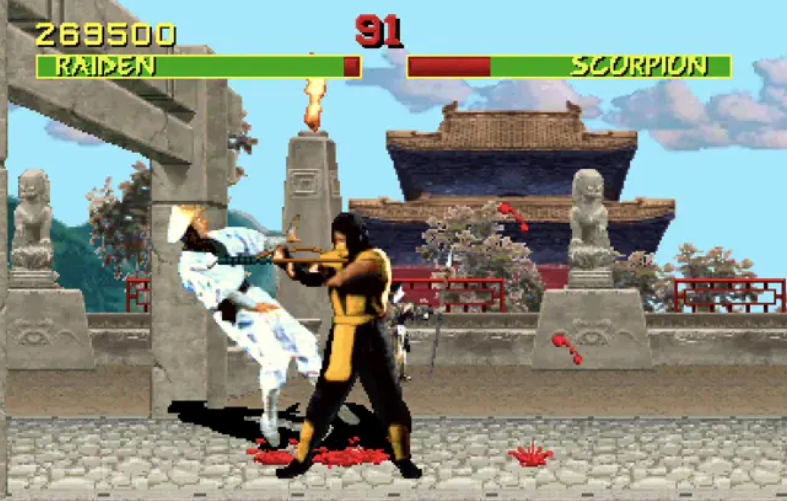
The intentions of game designers focused on the traditional fighting game rules, but they also wanted to add unique elements to the title (Diver). For instance, characters’ sprites were digitized, and the game was significantly gorier and bloodier than any fighting title before (Diver). It was the primary distinguishing feature of Mortal Kombat; yet, the developers did not implement any restricting ratings for the game (“Behind the Scenes”). In the rare footage of game development, the developers state, “Actually it is (the game is also meant for kids) – that is the big plan right here” (“Behind the Scenes”). In the 1990s, fighting games and video games, in general, were still niche, and the developers were commonly enthusiasts and innovators (Stuart). The industry was not as established and restricted as its current state, and developers could implement more creative and unique ideas. Hence, the designers primarily wanted to attract new people to fighting games and share the traditional gaming experience of the genre with several original elements.
Play Space and Objects
As mentioned before, the developers of Mortal Kombat took a unique approach to characters’ animations, hitboxes, and sprites. They achieved this visual style by capturing the videos of actors and martial artists on camera and then manually adjusting the footage (“Behind the Scenes”). The images below represent the general framework of filming and implementing 2-D sprites in the game:

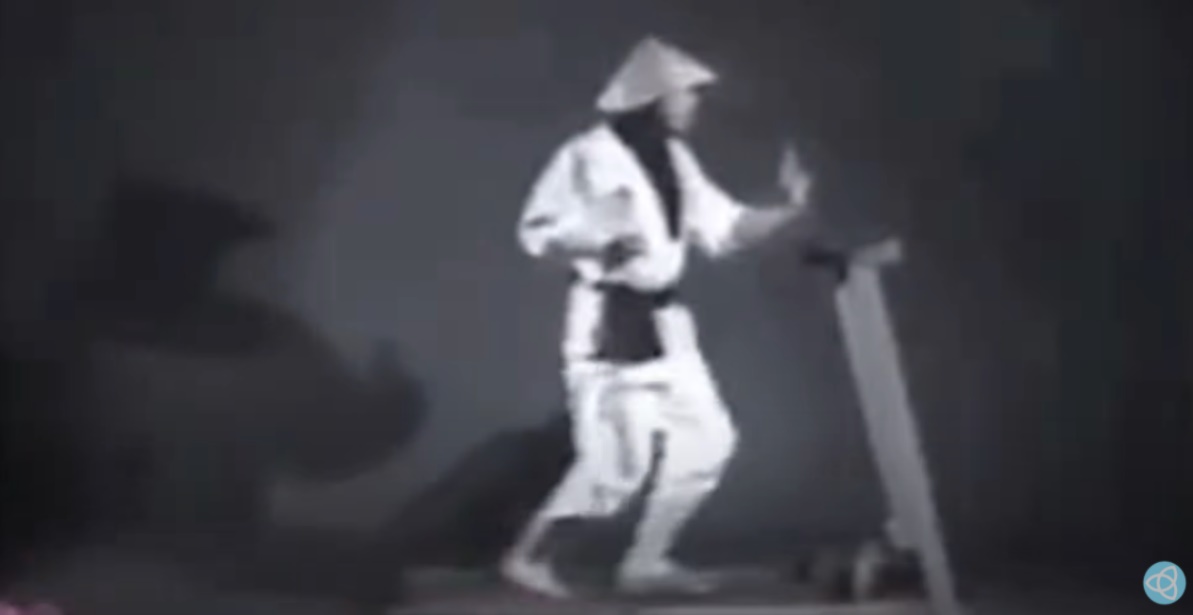
As a result, Mortal Kombat (1992) had seven characters that were the primary objects/assets in the game. All members of the initial roster became highly popular heroes that featured in movies and most iterations of Mortal Kombat in its 30-year history (see Fig. 4) (Diver).
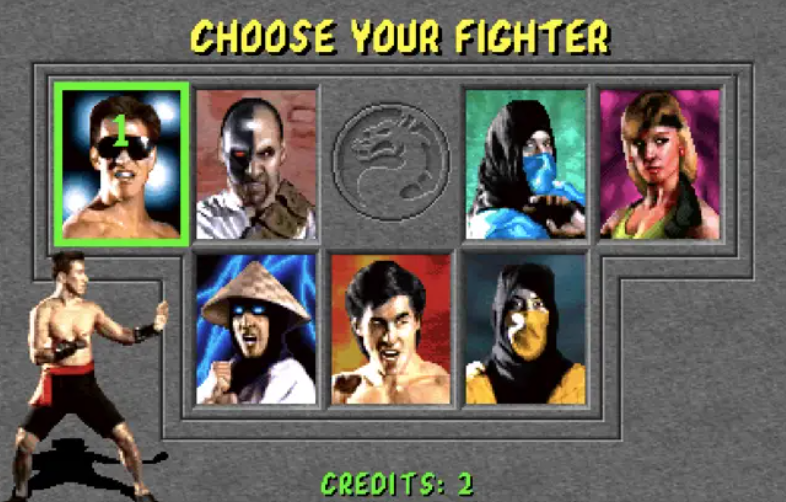
The play space included a fighting game arena – a carefully designed 2-D environment that represented specific locations in the lore of the game. Gameplay-wise, it was a simple background while the two characters can only move forward and backward on a horizontal line (see Fig. 5).
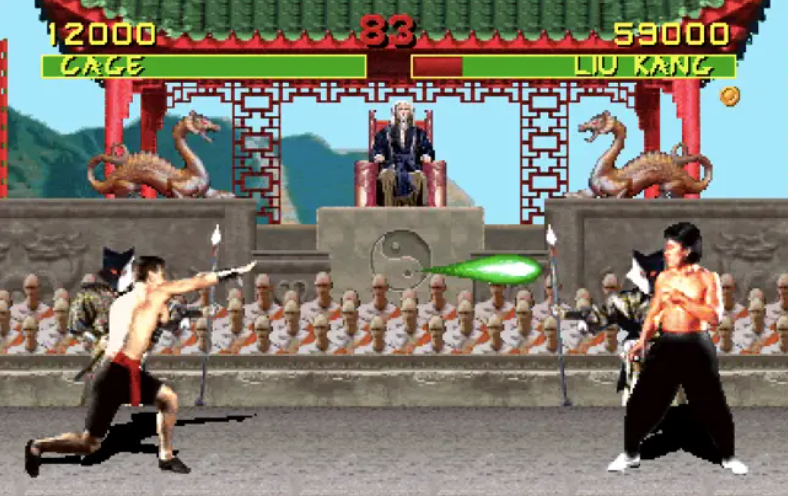
Player Actions
Developers took a traditional approach to player actions – every character can walk, run, attack, jump, crouch, and utilize special attacks in a 2-D space. Although all characters have the same approach to movement, offense, and defense, they have unique characteristics and inputs. For instance, Scorpion’s “Get Over Hear” attack is an iconic move that has been in every MK game, and even people not familiar with Mortal Kombat might know references to this action (“Evolution of Scorpion’s”). It is a projectile attack that tethers the opponent and brings them closer to Scorpion (see Fig. 6).
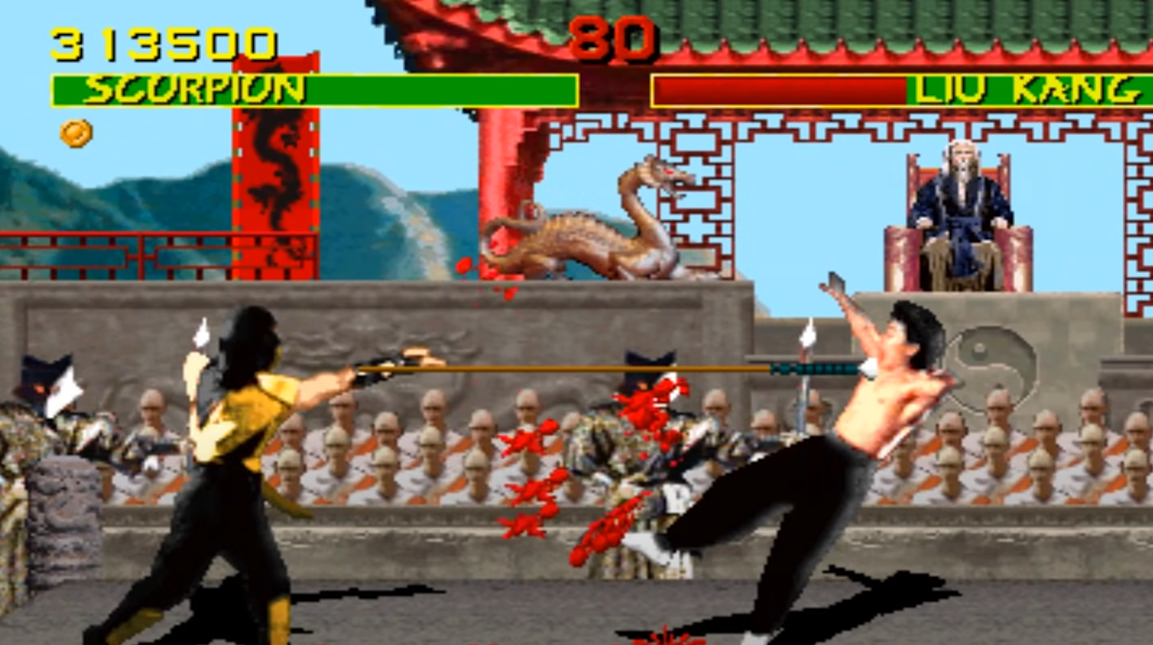
The developers chose these rules and mechanics of a traditional 2-D fighting game since players were already familiar and content with this approach (Stuart). Ultimately, Mortal Kombat continued the legacy of the first fighting games, but it put more emphasis on gore and a unique approach to animations/sprites.
Games Aesthetic
The primary distinctive feature of the Mortal Kombat series is a unique aesthetic of gore and blood. While the prior Japanese fighting games were hand-drawn and avoided the excessive usage of violent elements, Mortal Kombat decided to take a more direct approach (Stuart). In lore, “Mortal Kombat” is a fighting tournament to death, and all of the visual elements reflect this sense of danger and mortality (Diver). While the visuals in the 1992 iteration were not realistic due to hardware and software limitations, they were still gorier than any those of prior fighting games (see Fig. 7).
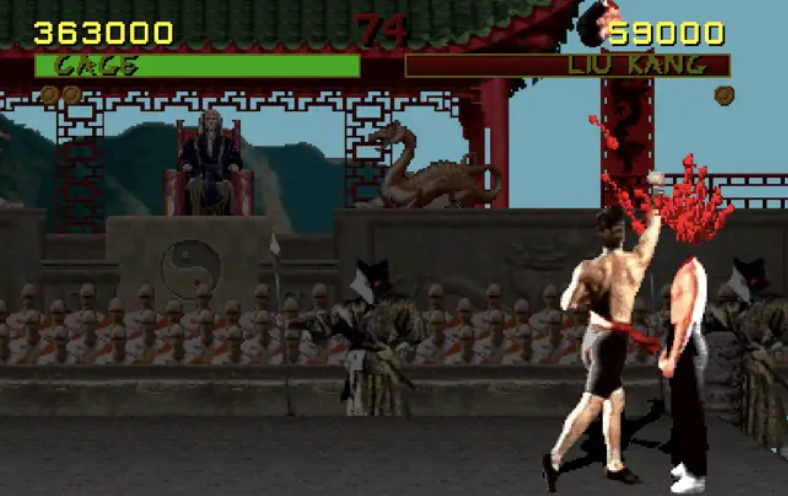
Ultimately, all gameplay elements and mechanics support the chosen aesthetic style to emphasize the cruel nature of Mortal Kombat.
Personal Recommendations
It is complicated to give recommendations to an iconic fighting game series that has been relevant for thirty years. Considering the 1992 iteration, I believe it could have benefitted from additional game modes. It is a relatively common tactic in modern titles, but in the 1990s, most fighting games had only one mode – a one-on-one battle (Stuart). More attention to lore by introducing a story mode or character-driven challenges could have attracted a less competitive audience. Another potential change is to expand the playable roster – not many players can find a character they want to play among only seven members. Regardless, Mortal Kombat was a highly successful title at the time even without additional changes.
Conclusion
The first Mortal Kombat released in 1992 drastically affected the scene of fighting games, being the first relevant American-based fighting title and introducing more gore. It retained the basic mechanics and gameplay of prominent games, such as Street Fighter 2, but also added unique elements to differentiate the product. As a result, many people have become loyal fans of the Mortal Kombat series and await future titles.
Works Cited
Alexander, Phill. “Esports: The Basics of the Fighting-Game Genre.” Dummies, Web.
“Behind the Scenes – Mortal Kombat 1 (Extended Version) [Rare Footage].” YouTube, uploaded by NeoGamer – The Video Game Archive, Web.
Diver, Mike. “Mortal Kombat: The Gory Fighting Game That Changed Everything.” Gaming Bible, Web.
“Evolution of Scorpion’s ‘Get Over Here’ (1992-2020).” YouTube, uploaded by GamelutioN, Web.
Stuart, Keith. “Kapow! The History of Fighting Games.” The Guardian, Web.
Wilds, Stephen. “Mortal Kombat Began Something Special: The Idea of Fighting Games with Lore.” Polygon, Web.